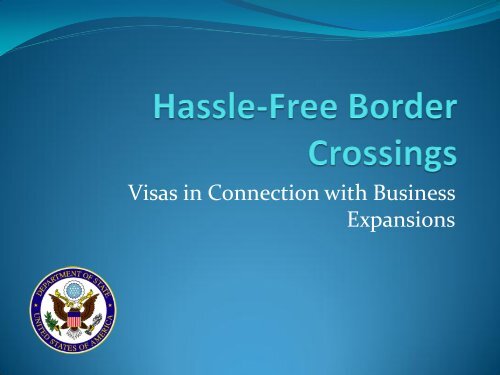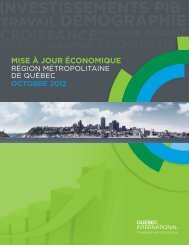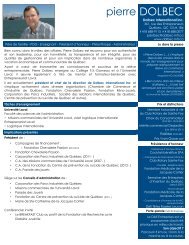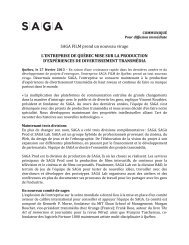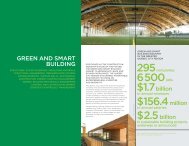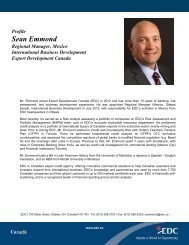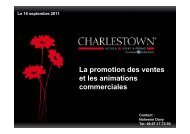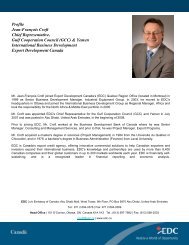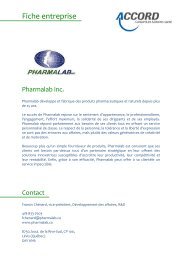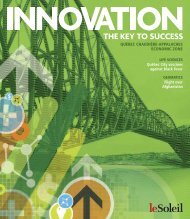What is a Visa?
What is a Visa?
What is a Visa?
Create successful ePaper yourself
Turn your PDF publications into a flip-book with our unique Google optimized e-Paper software.
V<strong>is</strong>as in Connection with Business<br />
Expansions
A citizen of a foreign country who seeks to enter the<br />
United States (U.S.) generally must first obtain a U.S.<br />
v<strong>is</strong>a, which <strong>is</strong> placed in the traveler’s passport. Certain<br />
international travelers may be eligible to travel to the<br />
U.S. without a v<strong>is</strong>a if they meet the requirements for<br />
v<strong>is</strong>a-free travel.
Canadian citizens are exempt from U.S. v<strong>is</strong>a<br />
requirements for most purposes of nonimmigrant<br />
travel to the United States. Canadians may apply for<br />
most entry into the United States as v<strong>is</strong>itors,<br />
temporary workers, or students directly at a U.S. port<br />
of entry or preclearance station.
The V<strong>is</strong>a Waiver Program (VWP) enables nationals of 36 participating<br />
countries to travel to the United States for tour<strong>is</strong>m or business (v<strong>is</strong>itor<br />
[B] v<strong>is</strong>a purposes only) for stays of 90 days or less without obtaining a<br />
v<strong>is</strong>a.<br />
• The program was establ<strong>is</strong>hed to eliminate unnecessary barriers to<br />
travel.<br />
• VWP eligible travelers may apply for a v<strong>is</strong>a, if they prefer to do so.<br />
• Nationals of VWP countries must meet eligibility requirements to<br />
travel without a v<strong>is</strong>a on VWP, and therefore, some travelers from VWP<br />
countries are not eligible to use the program.<br />
• VWP travelers are required to have a valid authorization through the<br />
Electronic System for Travel Authorization (ESTA) prior to travel, are<br />
screened at the port of entry into the United States, and are enrolled in<br />
the Department of Homeland Security’s US-VISIT program.
Currently, 36 countries participate in the V<strong>is</strong>a Waiver Program.<br />
The current l<strong>is</strong>t of countries <strong>is</strong> shown below:<br />
Andorra Hungary New Zealand<br />
Australia Iceland Norway<br />
Austria Ireland Portugal<br />
Belgium Italy San Marino<br />
Brunei Japan Singapore<br />
Czech Republic Latvia Slovakia<br />
Denmark Liechtenstein Slovenia<br />
Estonia Lithuania South Korea<br />
Finland Luxembourg Spain<br />
France Malta Sweden<br />
Germany Monaco Switzerland<br />
Greece the Netherlands United Kingdom
There are more than 30 different types of U.S. nonimmigrant<br />
v<strong>is</strong>as for everything from students, cultural exchanges,<br />
temporary employment, v<strong>is</strong>its for tour<strong>is</strong>m or business, starting a<br />
business, and more. The Department of State’s website at<br />
Travel.State.gov provides a wealth of information about all of<br />
these v<strong>is</strong>as and what <strong>is</strong> required to qualify for them.
There are a few v<strong>is</strong>a categories that are used by businesses most<br />
often to send employees to U.S.-based operations or to start<br />
new operations there. Those categories are:<br />
B-1 Business V<strong>is</strong>itors<br />
E-1/E-2 Treaty Trader/Treaty Investor<br />
H<br />
L<br />
Specialty occupations in fields requiring highly<br />
specialized knowledge<br />
Intra-company Transferees
The chart below provides an overview of temporary businessrelated<br />
travel permitted on business v<strong>is</strong>itor v<strong>is</strong>as.<br />
Purpose of Your Travel<br />
About Your Temporary V<strong>is</strong>it<br />
Business venture, investor seeking<br />
investment<br />
Conference, meeting, trade show or<br />
business event attendee<br />
Exposition or trade show employees<br />
of foreign exhibitors at international<br />
fairs (excludes government<br />
representatives)<br />
Lecturer or speaker<br />
Survey potential sites for a business and/or to lease prem<strong>is</strong>es in<br />
US. Cannot remain in US to manage business.<br />
Will receive no salary or income from a U.S based<br />
company/entity. For scientific, educational, professional or<br />
business purposes.<br />
Will receive no salary or income from a U.S based<br />
company/entity. Will plan, assemble, d<strong>is</strong>mantle, maintain, or<br />
be employed in connection with exhibits at international fairs<br />
or expositions.<br />
No salary or income from a U.S. based company/entity, other<br />
than expenses incidental to the v<strong>is</strong>it.
The chart below <strong>is</strong> an overview of key groupings of temporary<br />
business related travel permitted on business v<strong>is</strong>itor v<strong>is</strong>as.<br />
Purpose of Your Travel<br />
About Your Temporary V<strong>is</strong>it<br />
Researcher<br />
Sales/selling<br />
Service engineer (Commercial,<br />
Industrial)<br />
Training<br />
Independent research, no salary/income from a US based<br />
source, or benefit to US institution.<br />
Exhibition/taking orders/negotiating and signing contracts for<br />
products, which must be produced outside the U.S.<br />
Engineer(s) install, service or repair commercial or industrial<br />
equipment or machinery sold by a non-US company to a U.S.<br />
buyer, when specifically required by the purchase contract.<br />
Installation cannot include construction work, except for<br />
superv<strong>is</strong>ion or training of US workers to perform construction.<br />
Participating in a training program that <strong>is</strong> not designed<br />
primarily to provide employment. Will receive no payment or<br />
income from a U.S. based company/entity, other than an<br />
expense allowance or expense reimbursement related to<br />
traveler’s stay.
The Treaty Trader (E-1) or Treaty Investor (E-2) v<strong>is</strong>a <strong>is</strong> for a<br />
national of a country with which the United States (U.S.)<br />
maintains a treaty of commerce and navigation who <strong>is</strong> coming<br />
to the U.S. to carry on substantial trade, including trade in<br />
services or technology, principally between the U.S. and the<br />
treaty country, or to develop and direct the operations of an<br />
enterpr<strong>is</strong>e in which the national has invested, or <strong>is</strong> in the<br />
process of investing a substantial amount of capital, under the<br />
prov<strong>is</strong>ions of the Immigration and Nationality Act.
Treaty trader applicants must meet specific requirements to qualify for a<br />
treaty trader (E-1) v<strong>is</strong>a under immigration law. The consular officer will<br />
determine whether a treaty trader applicant qualifies for a v<strong>is</strong>a.<br />
• The applicant must be a national of a treaty country.<br />
• The trading firm for which the applicant <strong>is</strong> coming to the U. S. must have<br />
the nationality of the treaty country.<br />
• The international trade must be "substantial" in the sense that there <strong>is</strong> a<br />
sizable and continuing volume of trade.<br />
• The trade must be principally between the U.S. and the treaty country,<br />
which <strong>is</strong> defined to mean that more than 50 percent of the international trade<br />
involved must be between the U.S. and the country of the applicant's<br />
nationality.<br />
• Trade means the international exchange of goods, services, and technology.<br />
Title of the trade items must pass from one party to the other.<br />
• The applicant must be employed in a superv<strong>is</strong>ory or executive capacity, or<br />
possess highly specialized skills essential to the efficient operation of the firm.<br />
Ordinary skilled or unskilled workers do not qualify.
Treaty investor applicants must meet specific requirements to qualify for a treaty<br />
investor (E-2) v<strong>is</strong>a under immigration law. The consular officer will determine whether a<br />
treaty investor applicant qualifies for a v<strong>is</strong>a.<br />
• The investor, either a real or corporate person, must be a national of a treaty country.<br />
• The investment must be substantial and sufficient to ensure the successful operation<br />
of the enterpr<strong>is</strong>e.<br />
• The investment must be a real operating enterpr<strong>is</strong>e. Speculative or idle investment<br />
does not qualify.<br />
• The investment may not be marginal. It must generate significantly more income<br />
than just to provide a living to the investor and family, or it must have a significant<br />
economic impact in the U.S.<br />
• The investor must have control of the funds, and the investment must be at r<strong>is</strong>k in the<br />
commercial sense.<br />
• The investor must be coming to the U.S. to develop and direct the enterpr<strong>is</strong>e. If the<br />
applicant <strong>is</strong> not the principal investor, he or she must be employed in a superv<strong>is</strong>ory,<br />
executive, or highly specialized skill capacity. Ordinary skilled and unskilled workers do<br />
not qualify.
There are several different types of H-v<strong>is</strong>a sub-categories, but<br />
the most common type of H-v<strong>is</strong>a used by businesses to bring<br />
workers to the U.S. <strong>is</strong> the H-1B.<br />
The H-1B <strong>is</strong> for persons in a specialty occupation which requires<br />
the theoretical and practical application of a body of highly<br />
specialized knowledge requiring completion of a specific course<br />
of higher education. Th<strong>is</strong> category requires a labor certification<br />
from the U.S. Department of Labor and petition approval by the<br />
U.S. Citizenship and Immigration Service. The category <strong>is</strong><br />
numerically capped by law at 65,000 cases per year.
The L nonimmigrant classification enables a U.S. employer to<br />
transfer an executive or manager or a professional employee<br />
with specialized knowledge relating to the organization’s<br />
interests from one of its affiliated foreign offices to one of its<br />
offices in the United States. Th<strong>is</strong> classification also enables a<br />
foreign company which does not yet have an affiliated U.S. office<br />
to send an executive or manager to the United States with the<br />
purpose of establ<strong>is</strong>hing one. The employer must file Form I-129,<br />
Petition for a Nonimmigrant Worker, on behalf of the employee.
The U.S. Embassy and its Consulates all handle v<strong>is</strong>a applications on an<br />
appointment bas<strong>is</strong> only. The v<strong>is</strong>a process <strong>is</strong> summarized below:<br />
Prepare all requ<strong>is</strong>ite documents and materials for the v<strong>is</strong>a classification<br />
needed.<br />
Complete and submit the DS-160 online v<strong>is</strong>a application form.<br />
Pay the required v<strong>is</strong>a fees and schedule your v<strong>is</strong>a appointment at<br />
http://canada.usv<strong>is</strong>a-info.com.<br />
You may be required to send supporting documentation to the Embassy<br />
or Consulate prior to your interview.<br />
Appear at your interview at the appointed date and time. Please bring<br />
with you a recent v<strong>is</strong>a-sized photograph and any supporting<br />
documentation necessary.
Prior to the applicant’s interview with the consular officer, staff<br />
will intake any necessary documents and digital scans will be<br />
taken of the applicant’s fingerprints. All nonimmigrant v<strong>is</strong>a<br />
applicants are interviewed by a U.S. consular officer.<br />
During the interview, the consular officer will ask questions of<br />
the applicant related to the v<strong>is</strong>a category for which the<br />
individual has applied. Applicants should have any necessary<br />
supporting documents with them to provide to the officer, if<br />
requested. Interviews generally take only a few minutes and<br />
applicants are informed whether or not the v<strong>is</strong>a has been<br />
recommended for approval.
It generally takes a day or two after the v<strong>is</strong>a interview for the<br />
approved v<strong>is</strong>as to be printed and placed in the applicant’s<br />
passport. After the v<strong>is</strong>a <strong>is</strong> printed it <strong>is</strong> turned over to<br />
DHL/Loom<strong>is</strong> for delivery to the location selected by the<br />
applicant when they scheduled their appointment. When the<br />
passport <strong>is</strong> received at the delivery location an e-mail <strong>is</strong> sent to<br />
the applicant adv<strong>is</strong>ing that they can either pick up the passport<br />
or make arrangements for home delivery for an additional fee.
The U.S. Embassy website at http://canada.usembassy.gov provides<br />
v<strong>is</strong>a information and links to the Consulates in M<strong>is</strong>sion Canada.<br />
The Department of State’s travel website at http://travel.state.gov<br />
provides a wealth of information about U.S. v<strong>is</strong>as and other travel<br />
<strong>is</strong>sues.<br />
The U.S. Citizenship and Immigration Service’s website at<br />
http://www.usc<strong>is</strong>.gov provides information about petition-based v<strong>is</strong>a<br />
categories.<br />
The U.S. Customs and Border Protection website at<br />
http://www.cbp.gov details U.S. entry requirements and provides<br />
helpful suggestions for an efficient and problem-free entry.
Scott Feeken<br />
Nonimmigrant V<strong>is</strong>a Chief<br />
U.S. Consulate General, Toronto<br />
feekensg@state.gov


